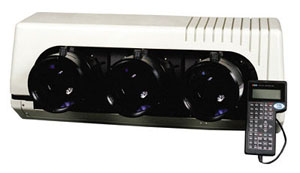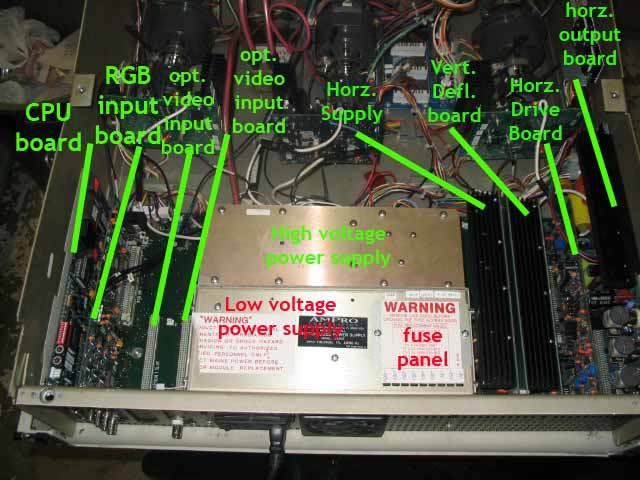 |
||||||||||||
| Home |
|
Products For Sale |
FAQs, Tips, Manuals |
Referral List |
|
Photo Gallery |
|
Links |
|
Contact Us |
|
|
||||||||||||||||
The layout of all Ampro projectors is very similar, from the older 2000 to the latest 4600. There are some board changes between models obviously, but if you’ve seen one Ampro, you’ve got a good idea of how most of them are laid out internally. The below view shows the main chassis view of a late model 3600. The 3400 and 4300/4600 sets are virtually identical. There are virtually no user serviceable parts on these boards. The later model Ampros did not have nearly as many trimpots on them as earlier sets. All boards in the back of the set mount to the back of the chassis with two small Philips screws. Take out the screws and the boards pull right out. (remember to UNPLUG the set before removing boards, or serious damage can occur).
Internal boards (going from left to right) CPU board: This board is quite reliable and has no user serviceable parts on it. The only part that fails occasionally on this board is the 3.6 volt lithium battery which is rated at about 5 years life, but typically lasts 10 years. Replace the battery or send the board in for service if it measures under 3.5 volts. When this battery dies, the set will still work, but the convergence memory will not hold when the set is unplugged. Also, the hour meter will usually glitch and indicated hundreds of thousands of days of use, as of this writing I have not found a way to reset the hour or CRT meter if this happens. RGB input board: All Ampro sets come stock with one RGB input board.
All RGB signal processing is on this board as is the test pattern generator.
Generally this board is reliable. With the amount of SMT parts on this board,
servicing by the end user is not recommended. H Supply board: This board supplies signals and voltages to the H
drive and output board. I have never had one of these fail. H output board: This board drives the H yokes on each tube. This board can fail, as high currents and voltages run through this board. There is a master H width trimpot on this board as well that does not normally require adjustments, but under certain resolutions you might find that you do not have enough width to make good use of the raster. If that’s the case, CAREFULLY adjust this trimpot so that you use a good amount of the tube face without running off the edge of the tube. HV power supply: The later HV power supplies were quite reliable, as the HV splitter section was removed from the supply itself, and thus the HV supply ran cooler than the older models. There are a number of HV supply models, some of which are interchangeable. Take a look at the part number, and we usually only refer to the last numbers in the model number as the supply type, ie. the X 1914, X 2102 or X 2394. This sticker is on the HV supply that is facing the green CRT socket. If you have an HVPS with a different model number but with the same connectors, chances are it will work. If the connectors are different, I would not try swapping them out. LV power supply: The LV supply is held to the frame by two screws on
each side of the top metal plate of the supply itself. Two screws face the RGB
board, two face the Horizontal Supply board. Loosen these screws (again, make
sure the power is disconnected from the set), and the LV power supply pulls
right out. There are no trimpots that should be adjusted on the LV power supply.
|
|
|||||||||||||||
© Copyright CurtPalme.com. All Rights Reserved. |

 Ampro 3600/4600
Ampro 3600/4600